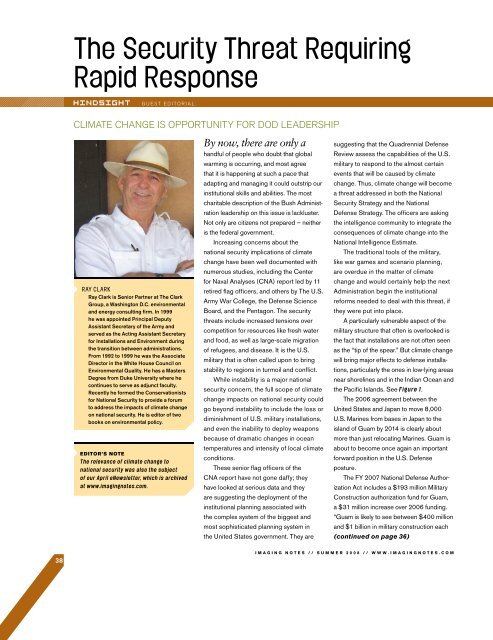download PDF - Imaging Notes
download PDF - Imaging Notes
download PDF - Imaging Notes
You also want an ePaper? Increase the reach of your titles
YUMPU automatically turns print PDFs into web optimized ePapers that Google loves.
GUEST EDITOR IALCLIMATE CHANGE IS OPPORTUNITY FOR DOD LEADERSHIPRay Clark is Senior Partner at The ClarkGroup, a Washington D.C. environmentaland energy consulting firm. In 1999he was appointed Principal DeputyAssistant Secretary of the Army andserved as the Acting Assistant Secretaryfor Installations and Environment duringthe transition between administrations.From 1992 to 1999 he was the AssociateDirector in the White House Council onEnvironmental Quality. He has a MastersDegree from Duke University where hecontinues to serve as adjunct faculty.Recently he formed the Conservationistsfor National Security to provide a forumto address the impacts of climate changeon national security. He is editor of twobooks on environmental policy.EDITOR’S NOTEBy now, there are only ahandful of people who doubt that globalwarming is occurring, and most agreethat it is happening at such a pace thatadapting and managing it could outstrip ourinstitutional skills and abilities. The mostcharitable description of the Bush Administrationleadership on this issue is lackluster.Not only are citizens not prepared — neitheris the federal government.Increasing concerns about thenational security implications of climatechange have been well documented withnumerous studies, including the Centerfor Naval Analyses (CNA) report led by 11retired flag officers, and others by The U.S.Army War College, the Defense ScienceBoard, and the Pentagon. The securitythreats include increased tensions overcompetition for resources like fresh waterand food, as well as large-scale migrationof refugees, and disease. It is the U.S.military that is often called upon to bringstability to regions in turmoil and conflict.While instability is a major nationalsecurity concern, the full scope of climatechange impacts on national security couldgo beyond instability to include the loss ordiminishment of U.S. military installations,and even the inability to deploy weaponsbecause of dramatic changes in oceantemperatures and intensity of local climateconditions.These senior flag officers of theCNA report have not gone daffy; theyhave looked at serious data and theyare suggesting the deployment of theinstitutional planning associated withthe complex system of the biggest andmost sophisticated planning system inthe United States government. They aresuggesting that the Quadrennial DefenseReview assess the capabilities of the U.S.military to respond to the almost certainevents that will be caused by climatechange. Thus, climate change will becomea threat addressed in both the NationalSecurity Strategy and the NationalDefense Strategy. The officers are askingthe intelligence community to integrate theconsequences of climate change into theNational Intelligence Estimate.The traditional tools of the military,like war games and scenario planning,are overdue in the matter of climatechange and would certainly help the nextAdministration begin the institutionalreforms needed to deal with this threat, ifthey were put into place.A particularly vulnerable aspect of themilitary structure that often is overlooked isthe fact that installations are not often seenas the “tip of the spear.” But climate changewill bring major effects to defense installations,particularly the ones in low-lying areasnear shorelines and in the Indian Ocean andthe Pacific Islands. See .The 2006 agreement between theUnited States and Japan to move 8,000U.S. Marines from bases in Japan to theisland of Guam by 2014 is clearly aboutmore than just relocating Marines. Guam isabout to become once again an importantforward position in the U.S. Defenseposture.The FY 2007 National Defense AuthorizationAct includes a $193 million MilitaryConstruction authorization fund for Guam,a $31 million increase over 2006 funding.“Guam is likely to see between $400 millionand $1 billion in military construction each(continued on page 36)38IMAGING NOTES // S UMMER 2008 // WWW.IMAGINGNOTES.COM











